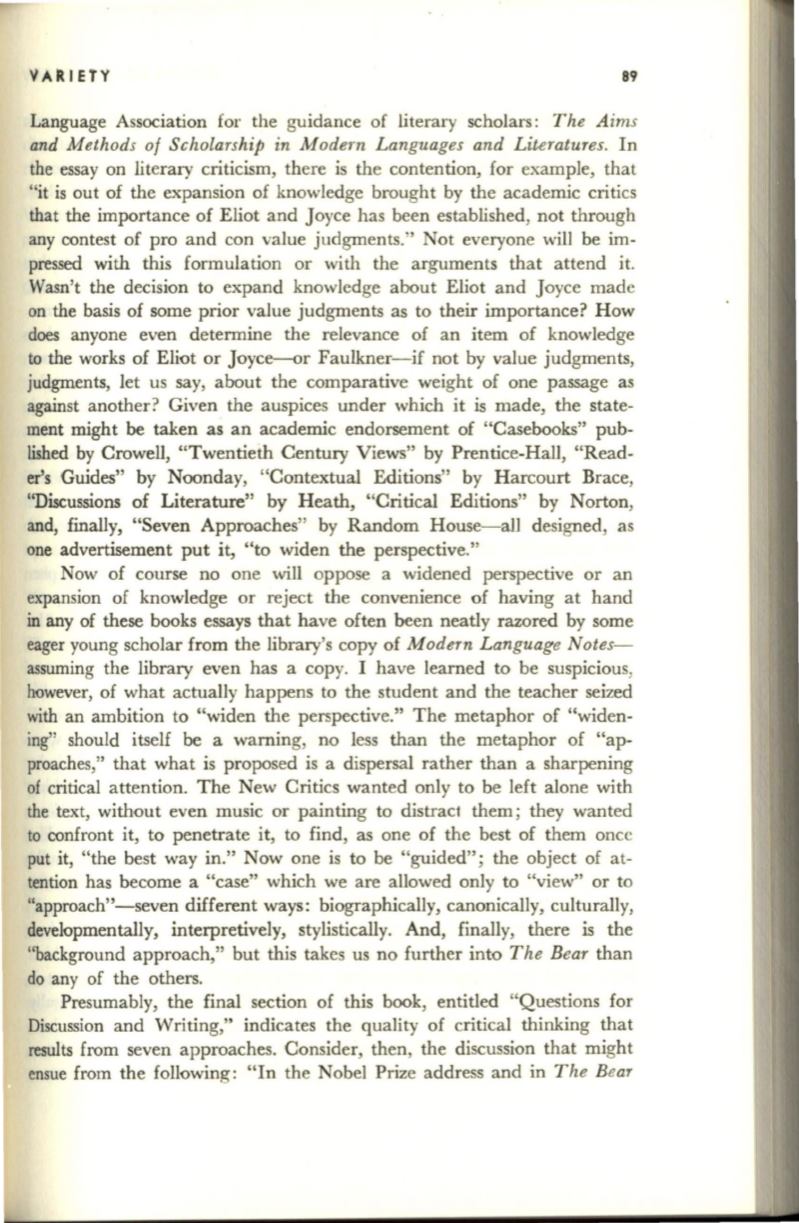
VARIETY
89
Language Association for the guidance of literary scholars:
The A ims
and Methods of Scholarship in Modern Languages and Literatures.
In
the essay on literary criticism, there is the contention, for example, that
"it is out of the expansion of knowledge brought by the academic critics
that the importance of Eliot and Joyce has been established, not through
any contest of pro and con value judgments." Not everyone will be im–
pressed with this formulation or with the arguments that attend it.
Wasn't the decision to expand knowledge about Eliot and Joyce made
on the basis of some prior value judgments as to their importance? How
does anyone even determine the relevance of an item of knowledge
to the works of Eliot or Joyce-or Faulkner- if not by value judgments,
judgments, let us say, about the comparative weight of one passage as
against another? Given the auspices under which it is made, the state–
ment might be taken as an academic endorsement of "Casebooks" pub–
lished by Crowell, "Twentieth Century Views" by Prentice-Hall, "Read–
er's Guides" by Noonday, "Contextual Editions" by Harcourt Brace,
"Discussions of Literature" by Heath, "Critical Editions" by Norton,
and, finally, "Seven Approaches" by Random House- all designed, as
one advertisement put it, "to widen the perspective."
Now of course no one will oppose a widened perspective or an
expansion of knowledge or reject the convenience of having at hand
in
any of these books essays that have often been neatly razored by some
eager young scholar from the library's copy of
Modern Language Notes–
assuming the library even has a copy. I have learned to be suspicious,
however, of what actually happens to the student and the teacher seized
with an ambition to "widen the perspective." The metaphor of "widen–
ing" should itself be a warning, no less than the metaphor of "ap–
proaches," that what is proposed is a dispersal rather than a sharpening
of critical attention. The New Critics wanted only to be left alone with
the text, without even music or painting to distract them ; they wanted
to confront it, to penetrate it, to find, as one of the best of them once
put it, "the best way in." Now one is to be "guided" ; the object of at–
tention has become a "case" which we are allowed only to "view" or to
"approach"-seven different ways: biographically, canonically, culturally,
developmentally, interpretively, stylistically. And, finally, there is the
"background approach," but this takes us no further into
The Bear
than
do any of the others.
Presumably, the final section of this book, entitled "Questions for
Discussion and Writing," indicates the quality of critical thinking that
results from seven approaches. Consider, then, the discussion that might
ensue from the following: "In the Nobel Prize address and in
The Bear


